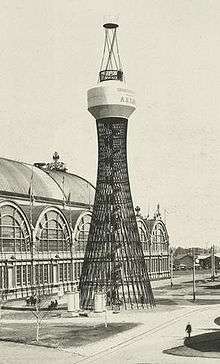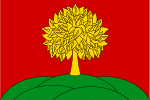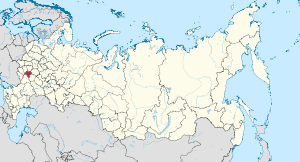Lipetsk Oblast
| Lipetsk Oblast Липецкая область (Russian) | |||
|---|---|---|---|
| — Oblast — | |||
| |||
|
| |||
| |||
|
| |||
| Political status | |||
| Country | Russia | ||
| Federal district | Central[2] | ||
| Economic region | Central Black Earth[3] | ||
| Established | January 6, 1954[4] | ||
| Administrative center | Lipetsk | ||
| Government (as of November 2014) | |||
| • Head of the Administration[5] | Oleg Korolyov[6] | ||
| • Legislature | Oblast Council of Deputies[7] | ||
| Statistics | |||
| Area (as of the 2002 Census)[8] | |||
| • Total | 24,100 km2 (9,300 sq mi) | ||
| Area rank | 71st | ||
| Population (2010 Census)[9] | |||
| • Total | 1,173,513 | ||
| • Rank | 44th | ||
| • Density[10] | 48.69/km2 (126.1/sq mi) | ||
| • Urban | 63.7% | ||
| • Rural | 36.3% | ||
| Population (January 2014 est.) | |||
| • Total | 1,159,866[11] | ||
| Time zone(s) | MSK (UTC+03:00)[12] | ||
| ISO 3166-2 | RU-LIP | ||
| License plates | 48 | ||
| Official languages | Russian[13] | ||
| Official website | |||
Lipetsk Oblast (Russian: Ли́пецкая о́бласть, Lipetskaya oblast) is a federal subject of Russia (an oblast).[4] Its administrative center is the city of Lipetsk. As of the 2010 Census, its population was 1,173,513.[9]
Geography
Lipetsk Oblast borders with Ryazan Oblast (NE), Tambov Oblast (E), Voronezh Oblast (S), Kursk Oblast (SW), Oryol Oblast (W), and Tula Oblast (NW).
History
According to archaeologists and historians, the territory in which for the time being is the Lipetsk Oblast was inhabited since ancient times. Even before the arrival of the Mongol-Tatar troops here were of Elec, Dobrinskaya (now the village of Good) Oaklet (now the village Oaks) (Dankovsky District), Old fort (Bogorodskoye Dankovsky district) Vorgol (destroyed), Onuza (destroyed), Voronozh (destroyed ), Lipetsk (destroyed) and others. During the Mongol invasion of Rus', many fortified cities had been destroyed.
Earth Lipetsk Oblast at the beginning of the period belonged to the disintegration of the Chernigov principality. After 1202, after the death of Chernigov Prince Igor Svyatoslavich Yelets arose, Lipetsk and Vorgolskoe fiefdoms. Taking advantage of the weakness of the principality of Chernigov, Ryazan princes seized all the lands of the upper Don, Voronezh River and annexed them to his possessions. For the newly acquired territories in the south of the Ryazan principality subsequently established name "Ryazan Ukraine."
The revival of the territory began after the expulsion of the nomads. In a relatively short period of time (end of the 16th and early 17th centuries) were built fortified city: Duncan Talitskii jail, Eletskaya fortress Lebedian. In 1635, construction began on a strong fortified line - Belgorod defense line, which in the Lipetsk region within a modern fortress stood out: Good, Sokolsk and Usman.
Near the plants have populations of workers. One of these settlements was working Lipetsk settlement that gave rise to the city of Lipetsk.
At this time, because of the creation of the Navy and the regular army increased the need for flax, hemp and wool. So begins to actively develop agriculture.
In the 18th century the continued growth of large landed estates. Lipetsk region, rich black earth, was the breadbasket of the state. Subsequently, he became widely known as a resort and mineral waters.
During the February Revolution, the October Revolution of 1917 and the Russian Civil War, the lives of many cultural values, private collections of art and literature, but because of the ensuing repression against the church and the "bourgeois past" seriously affected the architectural ensembles of the estates of the nobility, monasteries and churches.
The modern oblast was formed by the decree of the Presidium of the Supreme Soviet of the USSR on January 6, 1954 from parts of Voronezh, Ryazan, Tambov, Tula and Oryol Oblasts.[4]
Politics
During the Soviet period, the high authority in the oblast was shared between three persons: The first secretary of the Lipetsk CPSU Committee (who in reality had the biggest authority), the chairman of the oblast Soviet (legislative power), and the Chairman of the oblast Executive Committee (executive power). Since 1991, CPSU lost all the power, and the head of the Oblast administration, and eventually the governor was appointed/elected alongside elected regional parliament.
The Charter of Lipetsk Oblast is the fundamental law of the region. The Legislative Assembly of Lipetsk Oblast is the province's standing legislative (representative) body. The Legislative Assembly exercises its authority by passing laws, resolutions, and other legal acts and by supervising the implementation and observance of the laws and other legal acts passed by it. The highest executive body is the Oblast Government, which includes territorial executive bodies such as district administrations, committees, and commissions that facilitate development and run the day to day matters of the province. The Oblast administration supports the activities of the Governor who is the highest official, who acts as guarantor of the observance of the oblast Charter in accordance with the Constitution of Russia.
Since 1998, the Governor is Oleg Korolyov.
Economy
The most important industrial branches are the iron processing and the mechanical engineering. The most industrialized cities are Lipetsk, the administrative center, and Yelets. The region's fuel and energy complex is represented by petroleum product marketing companies, a network of consumer gas pipelines, and a power grid.
Agriculture
Crop cultivation and horticulture form the basis of the region's agriculture. Livestock farming specializes in cattle, pigs, goats, sheeps, and poultry. The processing industry is also well developed.
Administrative divisions
Demographics
Population: 1,173,513 (2010 Census);[9] 1,213,499 (2002 Census);[14] 1,230,220 (1989 Census).[15]
Ethnic composition (2010):[9]
- Russians: 96.3%
- Ukrainians: 0.9%
- Armenians: 0.6%
- Azerbaijanis: 0.3%
- Others: 1.9%
- 45,268 people were registered from administrative databases, and could not declare an ethnicity. It is estimated that the proportion of ethnicities in this group is the same as that of the declared group.[16]
Total fertility rate:[17]
2003 - 1,24 |
2004 - 1,28 |
2005 - 1,27 |
2006 - 1,28 |
2007 - 1,36 |
2008 - 1,43 |
2009 - 1,44 |
2010 - 1,47 |
2011 - 1,47 |
2012 - 1.63 |
2013 - 1.60 |
2014 - 1.66 |
2015 - 1.70(e)
Religion
According to a 2012 official survey[18] 71.3% of the population of Lipetsk Oblast adheres to the Russian Orthodox Church, 3% are unaffiliated generic Christians, 1% are Muslims, and 1% of the population adheres to the Slavic native faith (Rodnovery) movement. In addition, 15% of the population declares to be "spiritual but not religious", 6% is atheist, and 2.7% follows other religions or did not give an answer to the question.[18]
Attractions

The world's first hyperboloid structure—the steel open-work lattice tower—is located in Polibino, Dankovsky District of Lipetsk Oblast. The hyperboloid tower was built and patented in 1896 by the famous Russian engineer and scientist Vladimir Shukhov. The hyperboloid structures were subsequently built by other architects, such as Antoni Gaudí, Le Corbusier, and Oscar Niemeyer.
References
| Wikimedia Commons has media related to Lipetsk Oblast. |
Notes
- ↑ Article 13 of the Charter of Lipetsk Oblast states that the symbols of the oblast include a flag and a coat of arms, but not an anthem.
- ↑ Президент Российской Федерации. Указ №849 от 13 мая 2000 г. «О полномочном представителе Президента Российской Федерации в федеральном округе». Вступил в силу 13 мая 2000 г. Опубликован: "Собрание законодательства РФ", №20, ст. 2112, 15 мая 2000 г. (President of the Russian Federation. Decree #849 of May 13, 2000 On the Plenipotentiary Representative of the President of the Russian Federation in a Federal District. Effective as of May 13, 2000.).
- ↑ Госстандарт Российской Федерации. №ОК 024-95 27 декабря 1995 г. «Общероссийский классификатор экономических регионов. 2. Экономические районы», в ред. Изменения №5/2001 ОКЭР. (Gosstandart of the Russian Federation. #OK 024-95 December 27, 1995 Russian Classification of Economic Regions. 2. Economic Regions, as amended by the Amendment #5/2001 OKER. ).
- 1 2 3 Decree of January 6, 1954
- ↑ Charter of Lipetsk Oblast, Article 40
- ↑ Official website of the Administration of Lipetsk Oblast. Oleg Petrovich Korolyov, Head of the Administration of Lipetsk Oblast (Russian)
- ↑ Charter of Lipetsk Oblast, Article 25
- ↑ Федеральная служба государственной статистики (Federal State Statistics Service) (2004-05-21). "Территория, число районов, населённых пунктов и сельских администраций по субъектам Российской Федерации (Territory, Number of Districts, Inhabited Localities, and Rural Administration by Federal Subjects of the Russian Federation)". Всероссийская перепись населения 2002 года (All-Russia Population Census of 2002) (in Russian). Federal State Statistics Service. Retrieved 2011-11-01.
- 1 2 3 4 Russian Federal State Statistics Service (2011). "Всероссийская перепись населения 2010 года. Том 1" [2010 All-Russian Population Census, vol. 1]. Всероссийская перепись населения 2010 года (2010 All-Russia Population Census) (in Russian). Federal State Statistics Service. Retrieved June 29, 2012.
- ↑ The density value was calculated by dividing the population reported by the 2010 Census by the area shown in the "Area" field. Please note that this value may not be accurate as the area specified in the infobox is not necessarily reported for the same year as the population.
- ↑ Lipetsk Oblast Territorial Branch of the Federal State Statistics Service. Оценка численности городского и сельского населения по городским округам и муниципальным районам (Russian)
- ↑ Правительство Российской Федерации. Федеральный закон №107-ФЗ от 3 июня 2011 г. «Об исчислении времени», в ред. Федерального закона №271-ФЗ от 03 июля 2016 г. «О внесении изменений в Федеральный закон "Об исчислении времени"». Вступил в силу по истечении шестидесяти дней после дня официального опубликования (6 августа 2011 г.). Опубликован: "Российская газета", №120, 6 июня 2011 г. (Government of the Russian Federation. Federal Law #107-FZ of June 31, 2011 On Calculating Time, as amended by the Federal Law #271-FZ of July 03, 2016 On Amending Federal Law "On Calculating Time". Effective as of after sixty days following the day of the official publication.).
- ↑ Official on the whole territory of Russia according to Article 68.1 of the Constitution of Russia.
- ↑ Russian Federal State Statistics Service (May 21, 2004). "Численность населения России, субъектов Российской Федерации в составе федеральных округов, районов, городских поселений, сельских населённых пунктов – районных центров и сельских населённых пунктов с населением 3 тысячи и более человек" [Population of Russia, Its Federal Districts, Federal Subjects, Districts, Urban Localities, Rural Localities—Administrative Centers, and Rural Localities with Population of Over 3,000] (XLS). Всероссийская перепись населения 2002 года [All-Russia Population Census of 2002] (in Russian). Retrieved August 9, 2014.
- ↑ Demoscope Weekly (1989). "Всесоюзная перепись населения 1989 г. Численность наличного населения союзных и автономных республик, автономных областей и округов, краёв, областей, районов, городских поселений и сёл-райцентров" [All Union Population Census of 1989: Present Population of Union and Autonomous Republics, Autonomous Oblasts and Okrugs, Krais, Oblasts, Districts, Urban Settlements, and Villages Serving as District Administrative Centers]. Всесоюзная перепись населения 1989 года [All-Union Population Census of 1989] (in Russian). Институт демографии Национального исследовательского университета: Высшая школа экономики [Institute of Demography at the National Research University: Higher School of Economics]. Retrieved August 9, 2014.
- ↑ http://www.perepis-2010.ru/news/detail.php?ID=6936
- ↑ http://lipstat.gks.ru/wps/wcm/connect/rosstat_ts/lipstat/ru/statistics/population/
- 1 2 3 Arena - Atlas of Religions and Nationalities in Russia. Sreda.org
- ↑ 2012 Survey Maps. "Ogonyok", #34 (5243), 27/08/2012. Retrieved September 24, 2012.
Sources
- Липецкий областной Совет депутатов. №46-ОЗ 9 апреля 2003 г. «Устав Липецкой области», в ред. Закона №329-ОЗ от 5 декабря 2014 г. «О поправках к Уставу Липецкой области Российской Федерации». Опубликован: "Липецкая газета", №71, 17 апреля 2003 г. (Lipetsk Oblast Council of Deputies. Law #46-OZ of April 9, 2003 Charter of Lipetsk Oblast, as amended by the Law #329-OZ of December 5, 2014 On the Amendments to the Charter of Lipetsk Oblast of the Russian Federation. ).
- Президиум Верховного Совета СССР. Указ от 6 января 1954 г. «Об образовании в составе РСФСР Липецкой области». (Presidium of the Supreme Soviet of the USSR. Decree of January 6, 1954 On Establishing Lipetsk Oblast Within the RSFSR. ).
 |
|
|
 | |
| |
|
| ||
| ||||
| | ||||
| |
|



